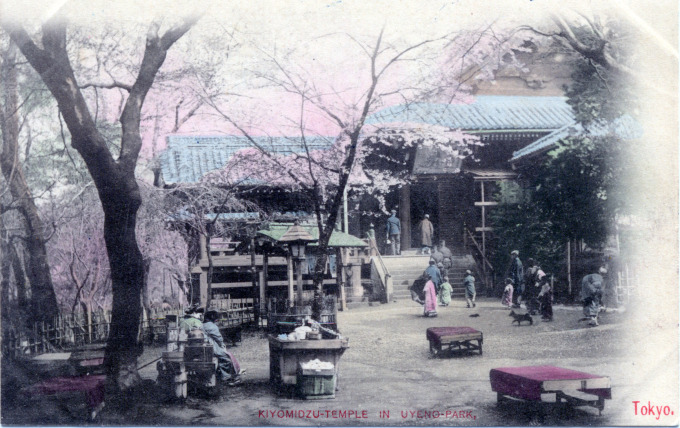
Ueno Kiyomizu Kannon-do was established by Abbot Tenkai Sojo, who was also the founder of the Kanei-ji Temple at Ueno. Kiyomizu was built in 1631 at the direction of the third Shogun, Tokugawa Iyemitsu. Its architecture is similar but structurally much smaller in scale compared to its model, the Kiyomizu-do in Kyoto. Miraculously, this Buddhist temple made it through the battles of Boshin civil war (1868-1869), the 1923 Great Kanto Earthquake, and World War II bombing raids. Today, Ueno Kiyomizu Kannon-do is recognized as the national treasure and one of the oldest temples in Tokyo.
“On the broad platform, built out on trestle work over the hillside in front of Kiyomizu in Uyeno, there are two scarlet pavilions, to right and left, where the visitor of the Goddess of Mercy may sit down to rest and take a cup of tea.
“Year in and year out the same old attendant presides over a brazier and a steaming kettle, ready at a moment’s notice to replenish a teapot. He spreads a thin cushion on a matting covered bench, and leaves the stranger to a contemplation of the scene.
“… [I]t is recalled that this temple was founded three centuries ago by Iyemitsu, the third shogun, who installed here a statue of a many-handed Kwannon, possessing miraculour powers. Associated with the image is a legend.
“Yorimoto, the lord of Kamakura, sought to destroy Morihisa of the Taira clan. Search was made for him, but could not be found.
“Night after night, Morihisa made a scret pilgrimage of Kiyomizu in Kyoto, having vowed to pray to Kwannon for a thousand times. He had completed eight hundred visits when he was discovered, sent to Kamakura and sentenced to die. On the execution ground he bowed his head in prayer to his protector, and the executioner was about to strike when the sword was broken into three pieces. Yoritomo, out of respect for the unseen influence that had saved Morihisa, spared his life.
“At the exact moment of the execution a statue of Kwannon at Kyoto toppled over, apparently without good cause, and when it was placed back in position, it was seen that on one of the arms there was a deep cut. The statue had received the blow of the executioner’s sword, and so prevented the weapon from descending upon the neck of Morihisa.
“The statue was given to Iyemitsu who built a temple in Uyeno for it, and here the legendary Goddess of Mercy has remained ever since.”
– Tokyo Vignettes, by Zoe Kincaid, 1933

